Swift 프로토콜 준수와 채택의 차이 : Difference between Conformance and Adoption in Swift Protocol
02 Jun 2019 |
Difference between Adoption and Conformance in Protocol - 프로토콜 채택, 준수의 차이
Protocol에서 Adoption(채택) 과 Conformance(준수)의 차이
Swift에서는 자료구조의 수평적 확장을 위해 Protocol 을 사용한다. Protocol으로 확장시에는 상속이라는 표현을 쓰지 않고 채택과 준수라는 단어를 사용한다.
하지만 둘의 차이점은 뭔지 확실하게 파악할 수 없었다. 처음에는 시점의 차이라고 생각했다. Protocol 시점에서 보면 기존에 존재하는 타입(exsisting type) 이 extension으로 준수하고, 존재하는 타입 입장에서는 protocol을 채택한다라고 생각했다.
하지만 오늘 swift language guide를 보다가 확실하게 구분할 수 있는 결정적인 topic이 있었다.
existing type에서 이미 protocol이 명세한 요구 조건(property or method)를 이미 구현해 놓은 상태라면, extension 과 protocol 이름만 명시하고, 구현부를 공백으로 두면 해당 타입이 그 프로토콜을 준수하게 된다.
여기서 결정적인 설명은 다음과 같다
If a type already conforms to all of the requirements of a protocol, but has not yet stated that it adopts that protocol, you can make it adopt the protocol with an empty extension:
protocol TextRepresentable {
var textualDescription: String { get }
}
struct Hamster {
var name: String
var textualDescription: String {
return "A hamster named \(name)"
}
}
extension Hamster: TextRepresentable {}
Hamster 구조체에서 이미 TextRepresentable protocol의 요구 사항을 구현한 상태라면, 빈 extension 에다가 protocol 이름만 덧붙이면 된다.
설명과 예시를 보고 파악한 내용은 다음과 같다.
구현한 것 → conform 준수
colon:으로 덧붙이는 부분 → adopt 채택
다시 설명하자면,
Hamster struct 에서 TextRepresentable protocol 의 요구 사항을 준수한 상태라면, 빈 extension으로 protocol을 채택하면 된다.
따라서, 준수와 채택의 차이는 코드에서의 위치로도 설명할 수 있다.
준수 (Conformance) -
{}안에서 요구사항 구현채택 (Adoption) -
Type : Protocol형식으로 명시하는 부분

기존에 내가 이해했던 시점, 관점의 차이도 어느정도 설명이 된다. 결국 타입 시점에서 프로토콜을 채택하면 : 를 추가하여 명시하는 과정이 필요하다. 프로토콜 관점에서 존재하던 타입이 해당 프로토콜을 준수하면, 구체적으로 요구 사항을 구현한다. 하지만 확실하게 어떤 부분이 준수이고 어떤 부분이 채택이다라고 설명하는데는 부족함이 있었다.
더 확실하게는 구현부에 대해서는 준수, 명시하는 부분은 채택 - 구현 위치로 표현을 다르게 사용하면 된다.